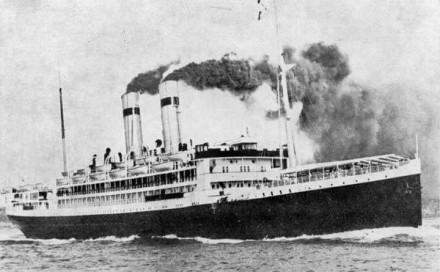History
Background
The SS Tubantia was built as a luxury passenger liner for Koninklijke Hollandsche Lloyd (Royal Holland Lloyd) shipping line, and performed a regular service between Amsterdam and Buenos Aires. Together with her sister ship SS Gelria she was the largest ship using Amsterdam as a home port. When she was built, she cost around 300.000 British pounds, and made extensive use of electricity onboard, making her one of the most luxurious ocean liners of the era.
After the outbreak of World War One, even though the Netherlands was a neutral party, passengers were hesitant to make transatlantic voyages, and the amount of passengers declined significantly. Because of this, the Tubantia was only carrying 80 passengers on her final voyage, out of a possible 1.477.
Loss
On the night of 15 March, 1916, she departed from Amsterdam, bound for Buenos Aires. Due to heavy fog, and the danger of the seaways, the Tubantia dropped anchor about 50 nautical miles off the coast of the Netherlands at about 2:00 A.M. to wait for the safety of daylight. At 2:30, members of Tubantia's crew spotted a stream of bubbles rapidly approaching the ship's starboard side. The bubbles were shortly followed by an explosion. Distress calls made by the sinking ship were answered by Dutch vessels, and all 80 passengers and 194 crew members were rescued before the Tubantia sunk four hours after the mysterious explosion, making her the largest neutral vessel sunk during the entire war.

Postcard of the Royal Holland Lloyd sister ships SS Gelria and Tubantia, published by the shipping line.
The aftermath
The sinking of the Tubantia led to a political struggle between the countries involved, the Netherlands on one side and Britain and Germany on the other, as neither of these two wanted to be seen as the aggressor against a neutral country, and the Netherlands wanted their neutrality in the war honored by those involved.
Germany was the first to react, proclaiming that the Tubantia must have been sunk by a British mine. Britain, not to be outdone, reacted by stating that a German torpedo must have been at fault. Germany concluded that if it had been a torpedo that had sunk the ship, it must have been a British one. It wasn't until a lifeboat from the Tubantia was recovered that the mystery was solved - the lifeboat contained bronze pieces from a torpedo, and as Germany was the only nation using bronze in their torpedoes, it was concluded that it was indeed a German weapon that sunk the ship.

Even after the discovery that it was indeed a German torpedo that sunk the Tubantia, Germany attempted to downplay their involvement. After the remains of the torpedo were identified as belong to the German vessel UB-13, Germany provided what would prove to be fake logs, asserting that the UB-13 was no where near the Tubantia at the time of the incident. It was Germany's assertion that the torpedo had been fired at a British vessel ten days earlier, missed, and subsequently struck the unfortunate Tubantia.
The Dutch saw this act as a hostile one, leading to a public outcry. To combat the wave of Dutch fury, German officials leaked fake news of an impending British invasion, which lead to a certain amount of panic among the population of the Netherlands.
Despite the denials and attempts at shifting blame, Germany offered recompense for the Royal Holland Lloyd, at the original amount of purchase for the Tubantia. This amount, 300.000 pounds, was denied, and an agreement was reached to have the matter arbitrated after the conclusion of the war. The matter was settled in 1922, and the Royal Holland Lloyd was awarded 830.000 pounds in damages from Germany.

Editorial cartoon by the Dutch artist Piet van der Hem, published in de Groene Amsterdammer (a left-wing periodical) in 1916, decrying the sinking of the SS Tubantia. From the mouth of the creature that resembles the German Kaisar, we see the words 'Es ist nicht war' ('It's not true').
Description
Type: steamer.
Yard: A. Stephen & Sons, Glasgow, yard no. 455.
Crew: 194.
Passengers numbers: 1.477 (252 1st class, 236 2nd class, 135 3rd class, 854 steerage).
Propulsion: 2 quadruple expansion engines, 2 screws.

| People on board | 274 |
|---|---|
| Power | 1725 hp |
| Speed | 16 knots ~ 18 mph (30 km/h) |
| Length | 560 feet (170.7 m) |
| Draft | 35 feet (10.7 m) |
| Beam | 65 ½ feet (20 m) |
| Tonnage | 13911 ton |
Status
Salvage attempts were made on the wreck of the Tubantia as early as 1924. A court case resulted from those attempts that still serves as the authority under English law regarding the salvage of shipwrecks.
There have been many salvage attempts since then. Some teams have even used dynamite to tear apart the hull, as the Tubantia is rumored to have carried around two million pounds worth of gold at the time of her sinking. None of the salvage teams have ever found any gold, however, and have only managed to destroy part of the structure of the remains.

References
- Meer info over vondsten.
Portable Antiquities Ensemble: TUBANTIA PAN-S-00108. - Wikipedia.
- Wrecksite.eu.
- Marhisdata.
Marhisdata.